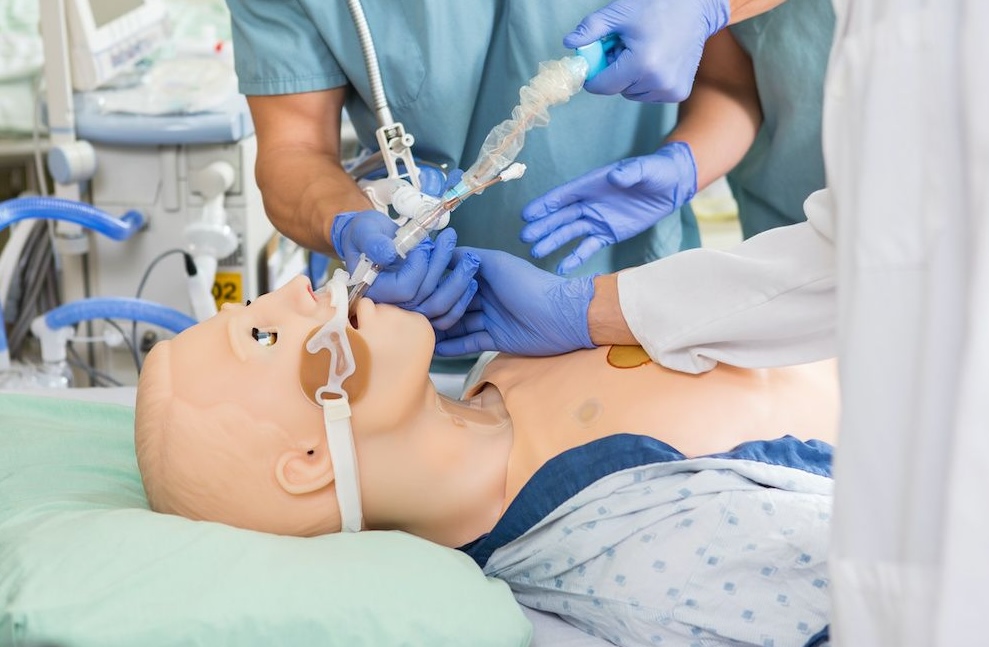Patient Controlled Analgesia (PCA) allows patients to manage their pain by self-administering small doses of intravenous analgesia within set limits. Today’s article is part of a multi-article series by guest authored by Kim Baily PhD, MSN, RN, CNE, previous Simulation Coordinator for Los Angeles Harbor College and Director of Nursing for El Camino College entitled “Physiology: The Force Behind Healthcare Simulation – A Guide for Techs” linked below. Over the past 16 years Kim has developed and implemented several college simulation programs and previously chaired the Southern California Simulation Collaborative. Today she shares more about PCA pain management buttons and how they can be used in medical simulation.
A specialized pump allows patients to press a button which signals the pump to release a predetermined dose of medication. Limits are set on the dose of medication the patient can receive and how frequently the dose can be delivered. Research has shown that when patients keep their pain within tolerable levels and receive regular small doses of pain medication, the total amount needed to keep the patient comfortable is less than when larger doses of pain medication are given further apart.
The PCA mode of therapy minimizes the roller-coaster effects of peaks of sedation and valleys of pain that occur with the traditional method of PRN dosing.
PCA Dosing
- MD order should contain the following information which is programmed into the PCA pump:
- Analgesic
- Morphine and Hydromorphone are the two most common analgesics used in PCA pumps
- Loading Dose (initial bolus) e.g. 1mg morphine
- Continuous infusion (basal infusion)
- Rarely used for opioid naive patients. E.g. 1 mg /hr.
- PCA dose:
- Dose received when patient presses button 2mg.
- Dose interval – time between doses e.g. 6, 8 or 10 minutes.
- No matter how frequently a patient pushes the button, they will only receive one dose within the preset dose interval.
- Maximum limit (Lockout interval) in one hour. This includes continuous dose and PCA dose. E.g. Maximum limit is 8 mg /hr. If continuous rate 1 mg /hr, and the dose received every time the patient hits the button is 1mg every 10 minutes (= maximum of 6 doses per minute). Total dose received = 7mg which is below the Maximum limit.
- Analgesic
- Normal saline at around 30 ml /hr to run continuously with the PCA may be used if no other IV fluid is prescribed.
- The most serious side effects include suppression of respiratory rate and sedation level. Along with RR and sedation level, vitals signs and pain level are routinely monitored.
- Patients and families must be educated about the use of PCA. Families should not press the button for patients (i.e. no PCA by proxy).
- Patients must be alert enough and physically capable of pressing the button at the appropriate interval.
- Poor mobility or confusion are contraindications for PCA use.
- Dosing for opiate naive patients and patients with opioid tolerance will be different.
- FDA defines opioid tolerance as patients who are have been taking, for a week or longer, at least 60 mg of morphine daily, or at least 30 mg of oral oxyCODONE daily, or at least 8 mg of HYDROmorphone daily or an equianalgesic dose of another opioid.
- The number of times a patient requests pain medication is recorded on the infusion pump. This number may indicate the level of pain control achieved. For example, when a PCA is set to give a dose of medication every 10 minutes but the patient presses the button every 2 minutes, this may indicate that the current regimen is not sufficient to control the patient’s pain. On the other hand, if a patient fails to press the button, this may indicate that the patient does not understand how to work the PCA, cannot physically push the button or their pain is low and they do not need the pain medication.
- Common side effects of opioid use include:
- Respiratory depression, sedation, constipation, nausea and vomiting, itching.
- The most serious of adverse reaction is opioid-induced ventilatory impairment (OIVI).
- Approximately 1 in 200 hospitalized postoperative surgical patients suffer from OIVI. One report identified 700 inpatient deaths in the U.S. directly attributed to patient-controlled analgesia between 2005 and 2009. (See guidelines from the The Joint Commission R3 Report issued in August 2017).
- Risk factors for OIVI include: Obesity, history of snoring or witnessed apneas, preexisting pulmonary or cardiac disease or dysfunction, smoker .
- The American Society of Anesthesiologists patient considers the following as additional risks for OIVI:
- Concomitant administration of sedating agents, such as benzodiazepines or antihistamines.
- Continuous opioid infusion in opioid-naïve patients, e.g., IV PCA (Patient-Controlled Analgesia) with basal rate.
- First 24 hours of opioid therapy.
- Thoracic and other large incisions that may interfere with adequate ventilation.
- Large single bolus techniques
- Naloxone administration: Patients given naloxone are at higher risk for additional episodes of respiratory depression.
- STOP-BANG mnemonic to identify patients at risk.
- Snoring—Do you snore loudly?
- Tired—Do you often have daytime tiredness, fatigue or sleepiness?
- Observed—Has anyone seen you stop breathing while you sleep?
- Blood Pressure—Do you have or are you being treated for high blood pressure?
- BMI >35 kg/m2?
- Age >50 years?
- Neck Circumference >40 cm
- Gender—Male?
Tips for Healthcare Simulation:
Patient Controlled Analgesia provides a useful strategy for patients to control their pain. Overall opioid use is usually reduced and patients report having better pain control. Since many institutions will not allow students to setup or operate PCAs, setup and operation of the PCA may be challenging for new healthcare practitioners or undergraduate students. Suggestions for scenarios.
- Set up new PCA including correct interpretation of written orders.
- Include patient and family teaching.
- Provide records which show patient has or has not been using the PCA.
- Have patient with low RR or difficult to arouse.
- Have family member pressing PCA button.
- Have PCA set up but with wrong medication.
- Have PCA set up but with expired tubing – learner will have to change out the system.
Healthcare simulation provides an ideal setting to allow practice and development of competence. When PCA mastery is the primary focus, the learning objectives should focus on safe medication administration and safe operation of a PCA.
Further Reading: “Pain assessment and management standards for hospitals” from the Joint Commission.
Learn more about Physiology: The Force Behind Healthcare Simulation – A Guide!
Read the Entire Physiology: The “Force” Behind Healthcare Simulation HealthySimulation.com Article Series:
- Part 1: Blood Pressure
- Part 2: Heart & Respiratory Rate
- Part 3: Pulse Oximetry
- Part 4: Diabetes
- Part 4B: Hypoglycemia & Excel Template for Simulated EHR
- Part 4C: Insulin
- Part 5: Sepsis
- Part 6A: Hypovolemia (Intro)
- Part 6B: Hypovolemia (Treatment & Simulation Tips)
- Part 7A: IV Fluids
- Part 7B: IV Site Access
- Part 7C: PCA for Pain
- Part 8: ABGs
- Part 9: Sepsis Labs








